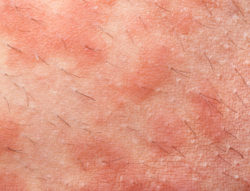Top Class Actions’s website and social media posts use affiliate links. If you make a purchase using such links, we may receive a commission, but it will not result in any additional charges to you. Please review our Affiliate Link Disclosure for more information.

Lamictal, also known as lamotrigine, is an anticonvulsant drug used to treat certain types of seizures associated with epilepsy. It’s also used to delay the onset of episodes of depression and mania in persons with bipolar disorder.
Lamictal is believed to work by decreasing abnormal electrical activity in the brain.
Though a few different side effects can occur with Lamictal treatment, one side effect in particular deserves significant attention from both patients and their physicians: Lamictal skin rash.
Even though a rash may only be a passing nuisance, Lamictal patients can’t afford not to take this side effect seriously. In rare cases, such a rash may be a sign the patient is developing Stevens Johnson syndrome, a potentially deadly drug reaction.
SJS Symptoms to Watch For
Stevens Johnson Syndrome, or SJS, is a condition that attacks the skin and mucous membranes. It can cause large areas of skin to peel away, exposing the patient to a risk of infection and significant dehydration.
The very earliest symptoms of SJS don’t affect the skin. They usually present as flu-like symptoms like cough, fever, body aches and sore throat. Because of their similarity to flu symptoms, they sometimes result in an initial misdiagnosis, which can cause a delay in treatment.
Soon after those first symptoms appear, skin symptoms of SJS may begin with a Lamictal skin rash. As this rash spreads over the body, blisters may form within the affected areas. These blisters can grow into large areas of skin that come loose and peel away from the lower layer of skin.
Similar lesions can afflict the mucous membranes that line the inside of the eyelids, mouth and throat, possibly making breathing or swallowing difficult. Eye symptoms often develop into conjunctivitis, an inflammation of the tissue that connects the eyelid to the white of the eye.
Treatment for SJS can require hospitalization for days or weeks, and sometimes even longer. The loss of outer skin exposes the patient to systemic infection, and constant medical care is necessary to prevent such an infection from taking hold.
Warning Label Advises Patients Not to Ignore Lamictal Skin Rash
Due to the risk that a Lamictal rash may develop into full-blown SJS, the drug’s label includes a black box warning addressing that danger. The FDA issues black box warnings for only the most serious possible side effects.
According to that warning, SJS occurs more frequently in younger Lamictal patients than in adults. Taking more Lamictal than recommended can also increase a person’s risk of SJS.
Most cases of Lamictal-related SJS seem to occur within the first two weeks of treatment. However, there have been isolated cases that did not begin until several months later.
The warning further notes that although Lamictal skin rash may be only benign, the drug should be discontinued at the first sign of a rash – unless it’s certain the rash is not drug-related. Even after the patient stops taking Lamictal, they still may run the risk to develop SJS.
Do YOU have a legal claim? Fill out the form on this page now for a free, immediate, and confidential case evaluation. The Stevens Johnson Syndrome attorneys who work with Top Class Actions will contact you if you qualify to let you know if an individual lawsuit or class action lawsuit is best for you. [In general, SJS lawsuits are filed individually by each plaintiff and are not class actions.] Hurry — statutes of limitations may apply.
ATTORNEY ADVERTISING
Top Class Actions is a Proud Member of the American Bar Association
LEGAL INFORMATION IS NOT LEGAL ADVICE
Top Class Actions Legal Statement
©2008 – 2024 Top Class Actions® LLC
Various Trademarks held by their respective owners
This website is not intended for viewing or usage by European Union citizens.
Get Help – It’s Free
Help for Victims of Stevens Johnson Syndrome
If you or a loved one were diagnosed with Stevens Johnson Syndrome (SJS) or toxic epidermal necrolysis (TEN) after taking a prescribed or over-the-counter medication, you may be eligible to take legal action against the drug’s manufacturer. Filing an SJS lawsuit or class action lawsuit may help you obtain compensation for medical bills, pain and suffering, and other damages. Obtain a free and confidential review of your case by filling out the form below.
An attorney will contact you if you qualify to discuss the details of your potential case at no charge to you.
Please Note: If you want to participate in this investigation, it is imperative that you reply to the law firm if they call or email you. Failing to do so may result in you not getting signed up as a client, if you qualify, or getting you dropped as a client.
Oops! We could not locate your form.












